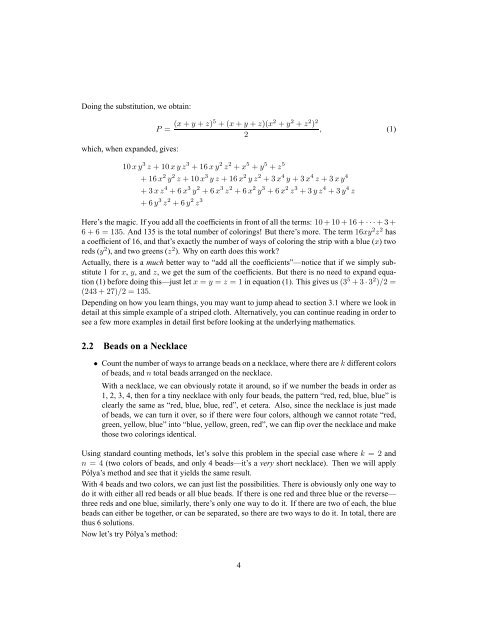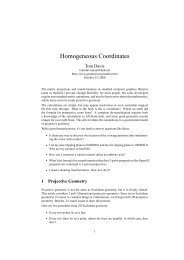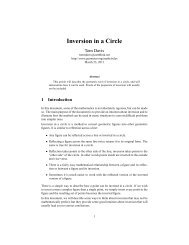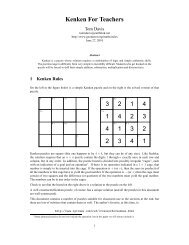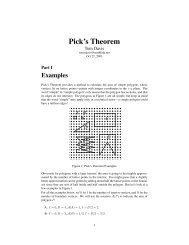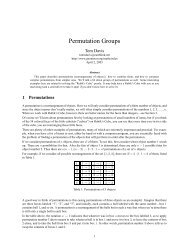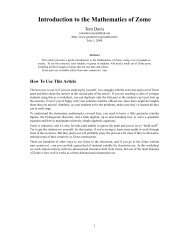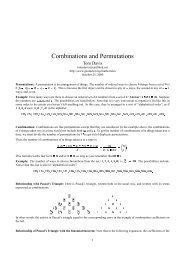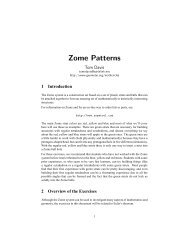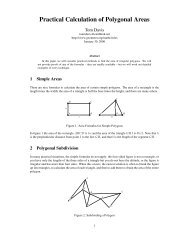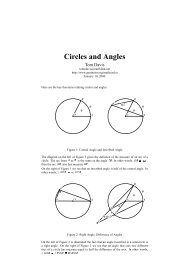P´olya's Counting Theory - Home Page -- Tom Davis
P´olya's Counting Theory - Home Page -- Tom Davis
P´olya's Counting Theory - Home Page -- Tom Davis
You also want an ePaper? Increase the reach of your titles
YUMPU automatically turns print PDFs into web optimized ePapers that Google loves.
Doing the substitution, we obtain:<br />
which, when expanded, gives:<br />
P = (x + y + z)5 + (x + y + z)(x 2 + y 2 + z 2 ) 2<br />
, (1)<br />
2<br />
10 xy 3 z + 10 xy z 3 + 16 xy 2 z 2 + x 5 + y 5 + z 5<br />
+ 16 x 2 y 2 z + 10 x 3 y z + 16 x 2 y z 2 + 3 x 4 y + 3 x 4 z + 3 xy 4<br />
+ 3 xz 4 + 6 x 3 y 2 + 6 x 3 z 2 + 6 x 2 y 3 + 6 x 2 z 3 + 3 y z 4 + 3 y 4 z<br />
+ 6 y 3 z 2 + 6 y 2 z 3<br />
Here’s the magic. If you add all the coefficients in front of all the terms: 10+10 + 16+···+3+<br />
6 + 6 = 135. And 135 is the total number of colorings! But there’s more. The term 16xy 2 z 2 has<br />
a coefficient of 16, and that’s exactly the number of ways of coloring the strip with a blue (x) two<br />
reds (y 2 ), and two greens (z 2 ). Why on earth does this work?<br />
Actually, there is a much better way to “add all the coefficients”—notice that if we simply substitute<br />
1 for x, y, and z, we get the sum of the coefficients. But there is no need to expand equation<br />
(1) before doing this—just let x = y = z = 1 in equation (1). This gives us (3 5 + 3 · 3 2 )/2 =<br />
(243 + 27)/2 = 135.<br />
Depending on how you learn things, you may want to jump ahead to section 3.1 where we look in<br />
detail at this simple example of a striped cloth. Alternatively, you can continue reading in order to<br />
see a few more examples in detail first before looking at the underlying mathematics.<br />
2.2 Beads on a Necklace<br />
• Count the number of ways to arrange beads on a necklace, where there are k different colors<br />
of beads, and n total beads arranged on the necklace.<br />
With a necklace, we can obviously rotate it around, so if we number the beads in order as<br />
1, 2, 3, 4, then for a tiny necklace with only four beads, the pattern “red, red, blue, blue” is<br />
clearly the same as “red, blue, blue, red”, et cetera. Also, since the necklace is just made<br />
of beads, we can turn it over, so if there were four colors, although we cannot rotate “red,<br />
green, yellow, blue” into “blue, yellow, green, red”, we can flip over the necklace and make<br />
those two colorings identical.<br />
Using standard counting methods, let’s solve this problem in the special case where k = 2 and<br />
n = 4 (two colors of beads, and only 4 beads—it’s a very short necklace). Then we will apply<br />
Pólya’s method and see that it yields the same result.<br />
With 4 beads and two colors, we can just list the possibilities. There is obviously only one way to<br />
do it with either all red beads or all blue beads. If there is one red and three blue or the reverse—<br />
three reds and one blue, similarly, there’s only one way to do it. If there are two of each, the blue<br />
beads can either be together, or can be separated, so there are two ways to do it. In total, there are<br />
thus 6 solutions.<br />
Now let’s try Pólya’s method:<br />
4


